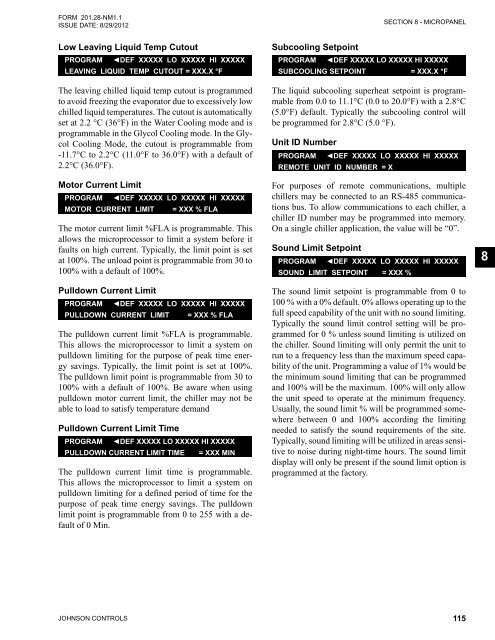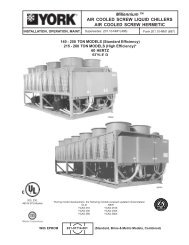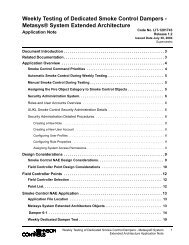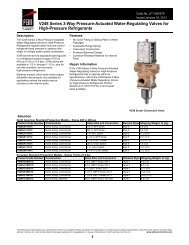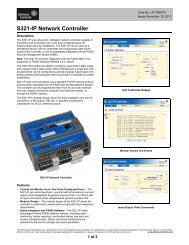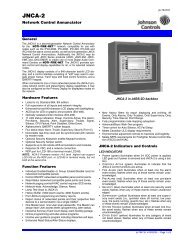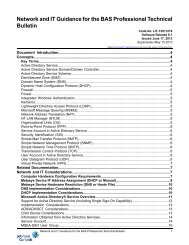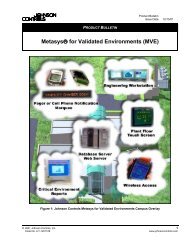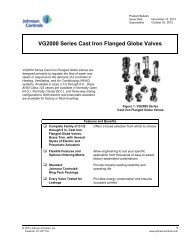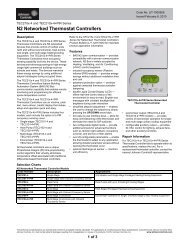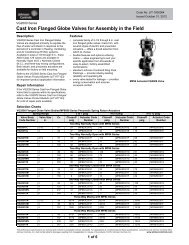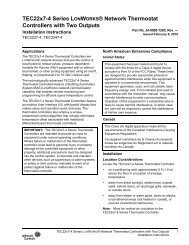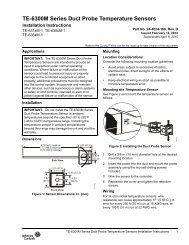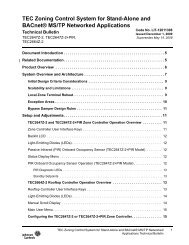YVAA Style A Air-Cooled Screw Liquid Chillers ... - Johnson Controls
YVAA Style A Air-Cooled Screw Liquid Chillers ... - Johnson Controls
YVAA Style A Air-Cooled Screw Liquid Chillers ... - Johnson Controls
Create successful ePaper yourself
Turn your PDF publications into a flip-book with our unique Google optimized e-Paper software.
FORM 201.28-NM1.1<br />
ISSUE DATE: 8/29/2012<br />
Low Leaving <strong>Liquid</strong> Temp Cutout<br />
PROGRAM ◄DEF XXXXX LO XXXXX HI XXXXX<br />
LEAVING LIQUID TEMP CUTOUT = XXX.X °F<br />
The leaving chilled liquid temp cutout is programmed<br />
to avoid freezing the evaporator due to excessively low<br />
chilled liquid temperatures. The cutout is automatically<br />
set at 2.2 °C (36°F) in the Water Cooling mode and is<br />
programmable in the Glycol Cooling mode. In the Glycol<br />
Cooling Mode, the cutout is programmable from<br />
-11.7°C to 2.2°C (11.0°F to 36.0°F) with a default of<br />
2.2°C (36.0°F).<br />
Motor Current Limit<br />
PROGRAM ◄DEF XXXXX LO XXXXX HI XXXXX<br />
MOTOR CURRENT LIMIT = XXX % FLA<br />
The motor current limit %FLA is programmable. This<br />
allows the microprocessor to limit a system before it<br />
faults on high current. Typically, the limit point is set<br />
at 100%. The unload point is programmable from 30 to<br />
100% with a default of 100%.<br />
Pulldown Current Limit<br />
PROGRAM ◄DEF XXXXX LO XXXXX HI XXXXX<br />
PULLDOWN CURRENT LIMIT = XXX % FLA<br />
The pulldown current limit %FLA is programmable.<br />
This allows the microprocessor to limit a system on<br />
pulldown limiting for the purpose of peak time energy<br />
savings. Typically, the limit point is set at 100%.<br />
The pulldown limit point is programmable from 30 to<br />
100% with a default of 100%. Be aware when using<br />
pulldown motor current limit, the chiller may not be<br />
able to load to satisfy temperature demand<br />
Pulldown Current Limit Time<br />
PROGRAM ◄DEF XXXXX LO XXXXX HI XXXXX<br />
PULLDOWN CURRENT LIMIT TIME = XXX MIN<br />
The pulldown current limit time is programmable.<br />
This allows the microprocessor to limit a system on<br />
pulldown limiting for a defined period of time for the<br />
purpose of peak time energy savings. The pulldown<br />
limit point is programmable from 0 to 255 with a default<br />
of 0 Min.<br />
SECTION 8 - MICROPANEL<br />
Subcooling Setpoint<br />
PROGRAM ◄DEF XXXXX LO XXXXX HI XXXXX<br />
SUBCOOLING SETPOINT = XXX.X °F<br />
The liquid subcooling superheat setpoint is programmable<br />
from 0.0 to 11.1°C (0.0 to 20.0°F) with a 2.8°C<br />
(5.0°F) default. Typically the subcooling control will<br />
be programmed for 2.8°C (5.0 °F).<br />
Unit ID Number<br />
PROGRAM ◄DEF XXXXX LO XXXXX HI XXXXX<br />
REMOTE UNIT ID NUMBER = X<br />
For purposes of remote communications, multiple<br />
chillers may be connected to an RS-485 communications<br />
bus. To allow communications to each chiller, a<br />
chiller ID number may be programmed into memory.<br />
On a single chiller application, the value will be “0”.<br />
Sound Limit Setpoint<br />
PROGRAM ◄DEF XXXXX LO XXXXX HI XXXXX<br />
SOUND LIMIT SETPOINT = XXX %<br />
The sound limit setpoint is programmable from 0 to<br />
100 % with a 0% default. 0% allows operating up to the<br />
full speed capability of the unit with no sound limiting.<br />
Typically the sound limit control setting will be programmed<br />
for 0 % unless sound limiting is utilized on<br />
the chiller. Sound limiting will only permit the unit to<br />
run to a frequency less than the maximum speed capability<br />
of the unit. Programming a value of 1% would be<br />
the minimum sound limiting that can be programmed<br />
and 100% will be the maximum. 100% will only allow<br />
the unit speed to operate at the minimum frequency.<br />
Usually, the sound limit % will be programmed somewhere<br />
between 0 and 100% according the limiting<br />
needed to satisfy the sound requirements of the site.<br />
Typically, sound limiting will be utilized in areas sensitive<br />
to noise during night-time hours. The sound limit<br />
display will only be present if the sound limit option is<br />
programmed at the factory.<br />
JOHNSON CONTROLS 115<br />
8


